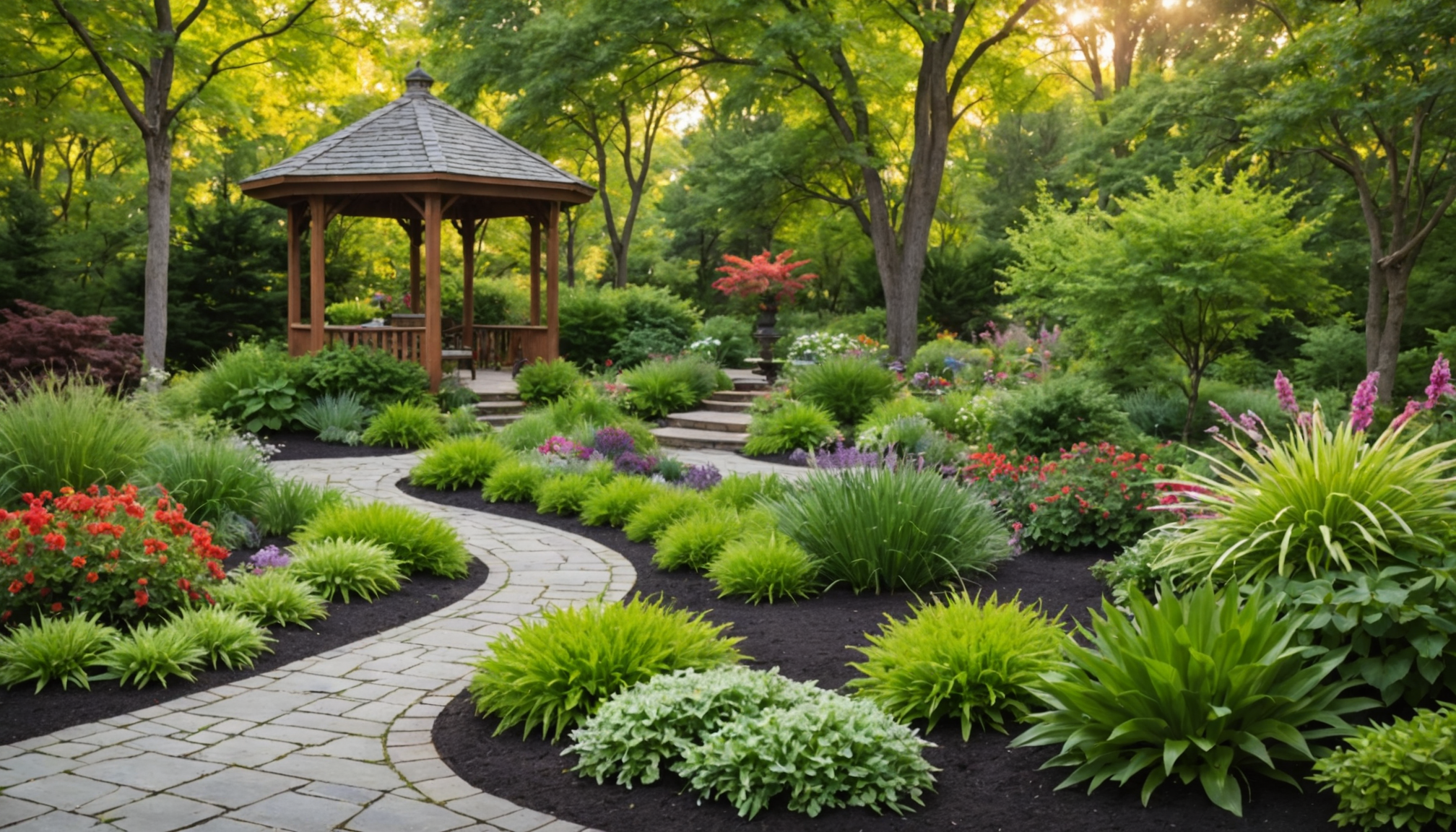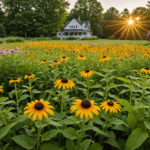Selecting appropriate plants is a foundational element in optimizing the curb appeal of your landscape. A well-thought-out plant selection not only complements the architectural style of your home but also enhances the overall aesthetic and ecological balance of your outdoor space. To choose the right plants, it is crucial to consider several factors, including climate compatibility, maintenance requirements, and the visual impact on your landscape.
First and foremost, understanding your local climate and soil conditions will significantly influence your plant choice. Each plant species has specific needs in terms of sunlight, water, and soil type. Here are a few steps to ensure your plant selections thrive in your environment:
- Assess Sunlight Availability: Determine the amount of sunlight each area of your yard receives. Choose plants that match these conditions, whether full sun, partial shade, or full shade.
- Evaluate Soil Quality: Conduct a soil test to understand pH levels and nutrient availability. This helps in selecting plants that will flourish without needing extensive soil modifications.
- Consider Climate Zones: Refer to the USDA Plant Hardiness Zone Map to identify plants that are well-suited for your region’s average minimum temperature.
In addition to climatological considerations, the maintenance requirements of plants are essential. Your lifestyle plays a vital role in determining whether low-maintenance or labor-intensive plants are more suitable. For those who may not have the time or desire for frequent gardening tasks, perennials, native plants, and drought-resistant species are excellent choices.
To create a balanced and visually appealing landscape, it is advisable to mix a variety of plant types, including trees, shrubs, flowers, and ground covers. Each type serves a unique purpose, from providing shade and creating structure to adding splashes of color and preventing soil erosion. Here is a comparative table to guide your choices:
| Plant Type | Benefits | Considerations |
| Trees |
|
|
| Shrubs |
|
|
| Perennials |
|
|
| Annuals |
|
|
| Ground Covers |
|
|
Finally, the aesthetic appeal of the plant selection cannot be underestimated. Think about the color palette you wish to incorporate — a cohesive scheme can create a relaxing atmosphere, while a more vibrant selection can add dramatic flair. Consider the architectural style of your home when choosing plants; for instance, symmetrical plantings tend to complement traditional architecture, whereas asymmetrical, natural plantings can enhance modern designs.
By carefully selecting plants that suit your climate, lifestyle, and design preferences, you can significantly boost the curb appeal of your home, creating an inviting and attractive landscape.
designing a functional layout
 To create a landscape that not only enhances your home’s aesthetic appeal but also serves its functional needs, it’s vital to plan a well-thought-out layout. Designing an effective layout involves a strategic approach to space management and the harmonious integration of different elements. Follow these steps to craft a landscape design that is both beautiful and practical:
To create a landscape that not only enhances your home’s aesthetic appeal but also serves its functional needs, it’s vital to plan a well-thought-out layout. Designing an effective layout involves a strategic approach to space management and the harmonious integration of different elements. Follow these steps to craft a landscape design that is both beautiful and practical:
1. Assess Your Yard's Potential:
– Begin by evaluating the existing conditions of your yard. Take note of any natural features such as slopes, trees, and views that you wish to highlight or obscure.
– Consider the yard’s size and shape, which will guide decisions regarding the size and placement of plants and other features.
2. Identify Functional Areas:
– Determine the primary activities that your landscape needs to accommodate. Common zones include relaxation areas, cooking spaces, children’s play zones, and gardening patches.
– Once areas of focus are identified, associate each zone with specific needs. For example, ensure that pathways lead conveniently to all key areas.
3. Create a Sketch:
– Draft a preliminary sketch of your yard. Include the house, existing features, and the functional areas you have identified.
– Use scale to represent dimensions accurately, which aids in visualizing your landscape’s layout.
4. Plan Your Circulation:
– Design practical and appealing circulation routes. Pathways should link areas of high use, guiding the eye and feet in an intuitive flow.
– Consider materials for pathways that complement your home’s exterior and provide stability underfoot.
5. Select Strategic Plant Placement:
– Arrange plants to serve functional roles, such as providing privacy or framing views. Use larger plants as anchors in corners or at pathway junctions for visual interest.
– Layer plant heights from back to front in flowerbeds to create depth and dimension.
6. Incorporate a Focal Point:
– A focal point, whether a striking plant, statue, or water feature, draws attention and adds interest to the landscape.
– Position the focal point in a strategic location where it can be enjoyed from multiple angles and locations throughout the yard.
7. Ensure Balance and Proportion:
– Strive for balance by spreading elements evenly across your design. Symmetrical arrangements typically suit formal styles, while asymmetry can enhance more casual and naturalistic designs.
– Keep proportions in mind; avoid overpowering small spaces with large features and vice versa.
8. Consider Future Growth:
– Plan for the mature size of plants and trees to avoid overcrowding.
– Leave space for potential expansions or changes you may desire in the future, such as additional seating or a vegetable garden.
9. Integrate Vertical and Horizontal Space:
– Use vertical elements like trellises or arbors to draw the eye upward and make smaller spaces feel more expansive.
– Horizontal elements can be highlighted through ground covers, decking, or paving, creating varied texture and continuity.
By meticulously planning the layout of your landscape, you form the groundwork for a cohesive design that seamlessly integrates form and function. A well-executed layout will enhance the beauty of your home while providing a fully usable outdoor space for various activities and enjoyment.
incorporating hardscape elements
 Incorporating hardscape elements into your landscaping design is a strategic way to enhance both the visual appeal and functionality of your outdoor space. Hardscaping refers to the incorporation of the non-living elements in a landscape, such as stone pathways, patios, decks, fountains, and retaining walls. These features serve as the backbone of your landscape design, providing structure and a foundation upon which the softer elements, like plants and flowers, can thrive.
Incorporating hardscape elements into your landscaping design is a strategic way to enhance both the visual appeal and functionality of your outdoor space. Hardscaping refers to the incorporation of the non-living elements in a landscape, such as stone pathways, patios, decks, fountains, and retaining walls. These features serve as the backbone of your landscape design, providing structure and a foundation upon which the softer elements, like plants and flowers, can thrive.
One of the primary benefits of hardscape elements is their ability to define specific areas within your landscape, creating a clear distinction between different functional zones. Patios and decks, for example, provide practical, flat surfaces ideal for seating and entertainment areas. These spaces offer a perfect retreat for outdoor dining or simply enjoying the surroundings, extending the living area of your home into the outdoors.
Pathways and walkways offer both aesthetic and functional benefits. They guide visitors through your landscape and can highlight particular areas, creating a sense of flow and movement. Materials such as natural stone, bricks, or gravel can complement your home’s architecture and landscape theme. Well-designed pathways not only enhance navigation but also contribute to the cohesiveness and unity of the overall landscape design.
Retaining walls provide structural support and are particularly beneficial in sloped gardens, preventing soil erosion and managing water runoff. These walls can be constructed from a variety of materials, such as stone, brick, or concrete, to either blend seamlessly with the earth or stand out as a striking architectural feature. Additionally, they offer the opportunity to create tiered garden beds, adding depth and dimension to your space.
Water features, like fountains, ponds, or waterfalls, add a sensory element to your landscape. The sound of water can create a serene, tranquil atmosphere, adding to the enjoyment of your garden. Water features also attract local wildlife, such as birds and butterflies, enhancing the ecological diversity of your space.
Lighting integrated into hardscape elements can transform your landscape in the evening hours, highlighting features and improving safety. Uplighting or downlighting on pathways, steps, or around seating areas can create an inviting ambiance while ensuring safe navigation after dark.
When incorporating hardscape elements, it’s important to consider the balance between hard and soft elements to avoid a design that feels too rigid or artificial. A harmonious blend of the two will result in a landscape that offers both beauty and utility, extending the usable space of your home and enhancing its overall curb appeal. Properly executed, hardscaping not only elevates the look of your property but also increases its functionality and enjoyment for years to come.
maintaining your landscape
 Proper care and maintenance of your landscape ensure that your yard remains a captivating and functional space year-round. An effective maintenance routine not only prolongs the life of your plants and hardscape features but also sustains the curb appeal and value of your property. By dedicating some time to regular upkeep, you can prevent minor issues from escalating into more significant problems, thus preserving the beauty and balance of your landscape.
Proper care and maintenance of your landscape ensure that your yard remains a captivating and functional space year-round. An effective maintenance routine not only prolongs the life of your plants and hardscape features but also sustains the curb appeal and value of your property. By dedicating some time to regular upkeep, you can prevent minor issues from escalating into more significant problems, thus preserving the beauty and balance of your landscape.
Firstly, embracing a seasonal maintenance plan is key. Each season presents unique challenges and opportunities for your landscape. In spring, focus on cleaning up debris left by winter, performing soil tests, and applying the necessary fertilizers to prepare your plants for the upcoming growing season. Prune any dead or damaged branches from trees and shrubs to encourage healthy growth. This is also an excellent time to plant new annuals and perennials, ensuring they have ample time to establish before the summer heat sets in.
Summer maintenance often revolves around monitoring water needs and managing pests. As temperatures rise, efficient irrigation becomes crucial. Consider installing drip irrigation or soaker hoses for targeted watering, reducing water waste and ensuring deep root hydration. Keep an eye out for signs of disease or insect infestations, addressing issues promptly to prevent significant plant damage.
In the fall, concentrate on preparing your landscape for the colder months ahead. Rake leaves and remove any spent plants or debris to prevent mold and disease. Cut back perennials and mulch flower beds to protect plant roots from harsh winter temperatures. Autumn is the perfect time to aerate lawns, allowing for better oxygen and nutrient penetration, and to introduce cool-season grass seeds if needed.
Winter maintenance involves safeguarding your landscape from snow and ice damage. Gently brush heavy snow off shrubs and tree branches to prevent breakage. Avoid using harsh chemical de-icers on walkways, as they can harm nearby plants; instead, use sand or cat litter to maintain traction. Planning ahead by maintaining equipment like snow blowers ensures you are prepared for the season’s challenges.
In addition to season-based maintenance, ongoing tasks should not be overlooked. Regular lawn care such as mowing, edging, and weeding keeps your yard looking pristine. Consistent inspection of hardscape elements, including ensuring pathways remain level and checking for loose stones or bricks, prevents accidents and maintains aesthetic integrity. Moreover, keeping an eye on the condition of lighting fixtures ensures they continue to enhance your landscape’s safety and ambiance after dusk.
Finally, don’t underestimate the impact of routine plant care—deadheading spent flowers and trimming overgrown branches can prolong blooming and maintain the neat appearance of your landscape. By following these guidelines and remaining vigilant about your landscape’s needs, you can enjoy an attractive, vibrant outdoor space that continuously enhances your home’s curb appeal.
enhancing with lighting
 Outdoor lighting plays a pivotal role in transforming a landscape from ordinary to extraordinary, especially when the sun goes down. Thoughtfully placed lighting not only emphasizes the architectural features of your home but also enhances the vibrancy of your plantings and hardscape elements. A well-illuminated landscape provides a warm, welcoming glow, making your outdoor space inviting and safer for evening activities.
Outdoor lighting plays a pivotal role in transforming a landscape from ordinary to extraordinary, especially when the sun goes down. Thoughtfully placed lighting not only emphasizes the architectural features of your home but also enhances the vibrancy of your plantings and hardscape elements. A well-illuminated landscape provides a warm, welcoming glow, making your outdoor space inviting and safer for evening activities.
Effective lighting design begins by identifying focal areas and pathways that require illumination. Start with the entryway, as its lighting sets the tone for guests. Use wall lanterns or overhead fixtures that match the style of your home to create a coherent look. Next, focus on pathways and steps by installing low-voltage lights. These enhance visibility, guide movement, and prevent tripping hazards after dark. Consider solar-powered options which are energy-efficient and easy to install.
Trees and larger shrubs can be highlighted with uplights, which are positioned at the base and directed upward. This technique grants them a dramatic presence, accentuating their forms and casting intriguing shadows. Meanwhile, downlighting or “moonlighting,” placed high up, mimics the effect of moonlight filtering through tree branches, offering a soft and ambient light over wide areas.
For patios, decks, or outdoor seating areas, integrate lighting that creates an ambient and cozy environment. String lights, lanterns, or LED candles can evoke a relaxed, intimate atmosphere, perfect for entertaining. Remember to pay attention to color temperature; warmer hues encourage relaxation, whereas cooler tones can feel harsh.
Water features, if present, gain a mesmerizing quality when accompanied by underwater lights, the gentle play of light and shadow on the water’s surface adding depth and interest to the landscape. Incorporating colored lighting can also alter the mood; blues and greens are calming, while reds and oranges inject warmth.
Safety and security are additional benefits of adequate outdoor lighting. Motion sensor lights around entrances and perimeters provide additional security without disturbing the neighbors. Timers and smart home integration afford control over lighting schedules, contributing to energy efficiency.
Incorporating lighting as a final touch ensures that your landscaping is not only a charming sight during the day but remains equally captivating at night. Thoughtfully designed lighting can dramatically boost curb appeal, transforming your home into a beacon of warmth and welcome.
In conclusion, landscaping is a multifaceted endeavor that extends beyond mere aesthetics. Through the careful selection of plants, a functional layout, strategic hardscaping, diligent maintenance, and enhanced lighting, you can greatly improve your home’s curb appeal. Each component works in harmony to create a vibrant, inviting environment that reflects personal taste while simultaneously adding value and enjoyment. By investing time and creativity into your landscape design, you ensure that your property stands out in its neighborhood, providing a beautiful and functional outdoor haven.

